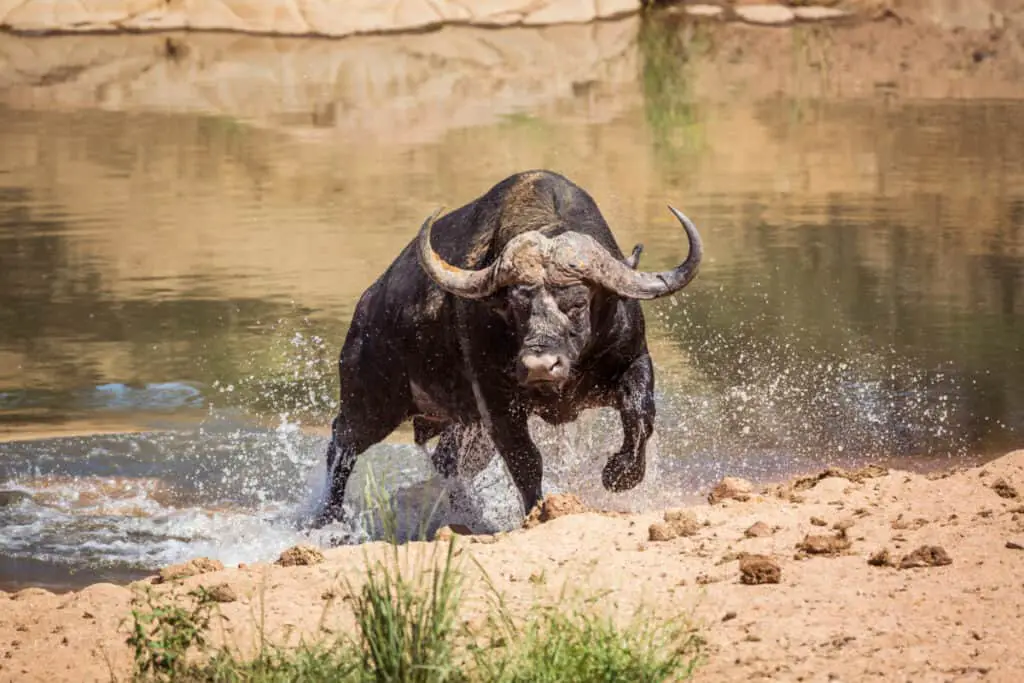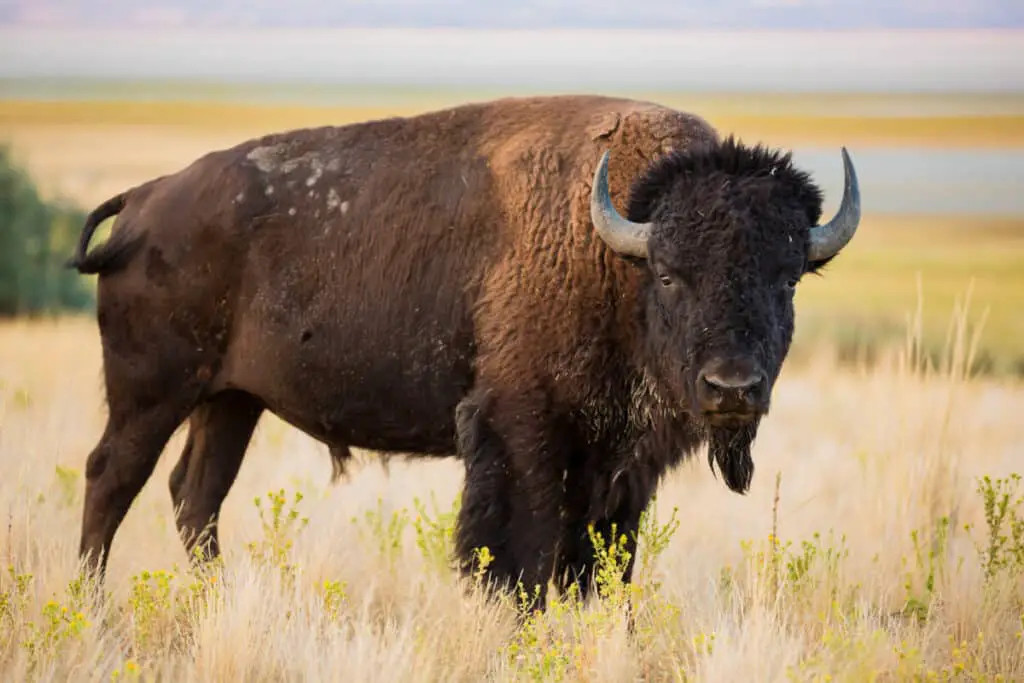Buffalo is a mammal of the Bovidae family, found in Africa and North America. The African buffalo (Syncerus caffer) belongs to the subfamily Bovinae, while the American bison (Bison bison) belongs to the subfamily Bisoninae. Both species are known for their massive size, distinctive horns, and important cultural significance.
The term ‘buffalo’ is often used interchangeably with ‘bison,’ but they are actually two different animals. While both have shaggy fur coats and large heads, buffalos have curved horns that sweep back, while bison have short horns that curve upward.
In this article, we will explore the physical characteristics, behaviors, habitats, and historical importance of these iconic animals.

Physical Characteristics Of African Buffalo
African buffalos, also known as Cape buffalo, are large bovines native to sub-Saharan Africa. These animals can weigh up to 1500 pounds and stand over 5 feet tall at the shoulder. Their distinguishing features include their massive horns that curve outwards from their head then down towards the ground in a V-shape. Horn structure varies depending on age and sex; males have thicker bases with larger outward curves compared to females.
Breeding patterns of African buffalos are polygamous, meaning males mate with multiple females during breeding season. This period typically occurs between February and May when food is abundant. Females carry their young for approximately eleven months before giving birth to one calf per pregnancy.
Calves stay close to their mothers until adulthood, which takes around three years. As herbivores, these mammals feed primarily on grasses but will occasionally consume leaves or fruits if available in their environment. The lifespan of an African buffalo ranges from ten to twenty-five years in the wild.
Physical Characteristics Of American Bison
The American Bison, commonly referred to as the buffalo, is a large mammal that once roamed freely throughout North America in massive herds. These animals are characterized by their shaggy fur coat which can range from dark brown to light tan and their distinctive horns which curve upward and inward.
The bison’s hump, located on its shoulders, contains powerful muscles used for digging through snow during winter months.
Bison distribution has been severely impacted due to human activity such as hunting and habitat destruction. However, conservation efforts have helped increase populations of these majestic creatures in recent years.
Some of these efforts include tracking individual bison movements with GPS technology and relocating them to areas where they can graze safely without being threatened by humans or predators.
Additionally, educating the public about the importance of preserving this species has also played a crucial role in protecting the bison’s future survival.
It is essential that we continue to prioritize conservation efforts to ensure that future generations will be able to witness these magnificent animals in their natural habitats.
Behaviors Of African Buffalo
Group dynamics are an important aspect of the behavior of African buffalo. These animals form large herds that can consist of several hundred individuals, with females and their offspring making up the majority of the group.
Males typically live alone or in small bachelor groups until they reach sexual maturity at around 5 years old. Within these herds, there is a hierarchy based on age, size, and strength.
Dominant males will often compete for access to mating opportunities with females during breeding season, which occurs between March and May. During this time, males engage in intense battles using their horns to establish dominance over other males and secure mating rights with receptive females.
The social structure of African buffalo allows for cooperation among members when it comes to finding food and protecting against predators such as lions.
Behaviors Of American Bison
As the massive creatures roam across their grassy plains, they display a variety of fascinating behaviors.
Like many animals, American bison live in groups that are ordered by complex group dynamics. Dominant males lead these herds and have priority access to resources like food and water. Meanwhile, subordinate bulls will often form bachelor groups until they can secure a mate.
During mating season, male bison engage in impressive displays of power and stamina as part of their mating rituals. These typically involve head-butting contests between competing males, which serve to establish dominance within the herd.
Once a bull has established himself as dominant over other males, he is then able to court receptive females for mating opportunities.
Overall, the social structures and breeding behaviors of American bison offer an intriguing glimpse into the natural world’s intricate workings without fail to amaze us all with its beauty and complexity.
Habitats Of African Buffalo And American Bison
The African buffalo (Syncerus caffer) is an herbivorous mammal that inhabits various ecosystems across sub-Saharan Africa. These habitats include savannas, forests, and wetlands. The migration patterns of African buffalos vary depending on the availability of food and water sources in their habitat.
During the dry season, they tend to migrate towards areas with permanent water sources while during the rainy season, they disperse into different parts of their range in search of fresh grass.
Although African buffalo populations are relatively stable throughout most of their habitat range, there have been some notable population declines due to poaching and disease outbreaks among herds. Conservation efforts aimed at protecting these animals mainly focus on anti-poaching patrols and vaccination campaigns against diseases such as anthrax and foot-and-mouth disease.
Despite these efforts, however, illegal hunting remains a significant threat to the survival of this species in certain regions where it has economic or cultural value.
The American bison (Bison bison), also known as the American buffalo, was once widespread across North America before overhunting led to near extinction by the end of the 19th century. Today, conservation efforts have helped restore bison populations through breeding programs and reintroduction projects.
Bison hold cultural significance for many Native American tribes who consider them sacred animals that represent strength and resilience. They have also been featured prominently in popular culture depictions such as sports team logos and western films.
While still facing threats from habitat loss and climate change impacts on grazing lands, conservationists remain hopeful that continued efforts will help ensure the long-term viability of this iconic animal species for future generations to come.

Historical Significance Of Buffalo In African And Native American Cultures
Symbolic representation of the buffalo is a significant aspect in both African and Native American cultures.
In Africa, the buffalo has been revered as an emblem of strength and power. It was also believed to offer protection from harm and evil spirits. Therefore, the animal featured prominently in religious ceremonies, rituals, and artwork.
Similarly, Native American communities view the buffalo as sacred animals that embody spirituality, abundance, and respect for nature.
The Plains Indians relied heavily on buffalos for their livelihoods; they used every part of the animal – meat for food, hides for clothing, bones for weapons and tools.
For these reasons, many tribes held annual ceremonies such as the Buffalo Dance or Sun Dance to honor this essential creature.
Overall, cultural practices and beliefs surrounding buffalo have played crucial roles in shaping traditional values across various indigenous societies.
Conclusion
The buffalo, also known as the bison, is a majestic animal that has captured the attention of humans for centuries. Both African buffalos and American bison share similar physical characteristics such as their massive size and distinctive horns, yet they have distinct differences in appearance.
In terms of behavior, both species display unique attributes including protective maternal instincts in females and dominance displays by males during mating season. Additionally, African buffalos are known for their aggressive nature when threatened while American bison tend to be more docile.
The habitats of these animals also differ with African buffalos thriving in grasslands and savannas while American bison are found primarily in prairies and forests.
Despite these variations, one common thread between both species is their historical significance in shaping cultural traditions among native peoples. The buffalo has long been revered as a symbol of strength, resilience, and freedom among indigenous communities throughout Africa and North America alike.
As we reflect on the symbolism of the buffalo, it reminds us of our own human struggles against adversity. Just like these magnificent beasts who persevere through harsh conditions in their natural habitats, we too can draw inspiration from them to overcome challenges that life may throw our way.
Whether it’s honoring ancestral traditions or finding inner strength within ourselves, let us pay homage to this incredible creature which represents so much more than just an animal – but rather a testament to the power of survival and perseverance.
